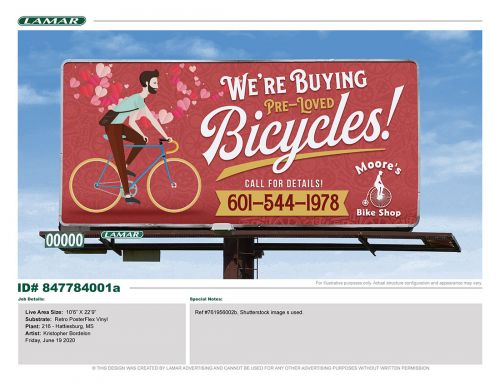A version of this article ran in the August issue of BRAIN.
HATTIESBURG, Miss. (BRAIN) — This could be shaping up as the summer of pre-love — that is, sales of “pre-loved” bicycles, as retailer James Moore likes to call them.
Like many retailers, Moore deals with the overwhelming demand for bikes because of the COVID-19 pandemic. With supply chains drying up, the owner of Moore’s Bike Shop is eager to buy used bikes and accept them as trade-ins.
He even recently bought billboard space in town and is running newspaper ads.
“We have folks call first, then text me photos, then if the bike meets our strategy, I'll go and make an in-person offer and pay on the spot,” Moore said. “Since we have a reputation of good refurbished bicycles, I don't expect the new bike shortage to slow us down.”
Bicycle Blue Book, which tracks and lists used-bike values, has been busy, focusing more resources on its Value Guide to accurately report on the current sales trends, said Chris McLaren, BBB president.
“There has been a significant increase in the selling price of used bikes from both private parties and used-bike retailers,” McLaren said. “We expect this to last until inventory is available again at retail and then prices will gradually level out.”
Until then, BBB will be busy.
“We are excited for new bike inventory to arrive in the near future as it should result in amazing business for all,” McLaren said.
The Pro’s Closet sees increased demand
Demand is up at The Pro’s Closet, the pre-owned bike retailer based in Boulder, Colorado. Matt Heitmann, chief marketing officer, said June web sales were up 288% year-over-year.
“TPC has definitely experienced tailwinds with the demand for bikes,” Heitmann said. “Our YoY growth plans were already very aggressive, with a goal of 100% topline growth. We were achieving this heading into COVID. When stay-at-home was enforced, for the first few days we saw a drop both in website traffic and sales, but this rebounded very quickly, and our sales went back to pre-COVID levels, and soon well beyond those.”
TPC’s average order value for the first six months of this year was up 35%, with “post-COVID sales driving the majority of that increase,” he said.
TPC’s average sales price for road and mountain bikes was up 15%.
“Our aggregated bike ASP is now $3,600,” he said. “What we have seen runs contrary to what a lot of IBDs and the industry in general are reporting: We are selling the top of the pyramid in terms of price, spec’, and brand, or what we would categorize as A-plus and A-level product. B-level product ($1,500 to $2,500) has certainly shown very strong sell-through-rates and is up YoY, but nowhere near as strong as our high-priced product.”
Nonprofit stores that focus on used bike sales are also seeing sales increases.
For example, Boulder’s Community Cycles experienced a 12% jump in 2020, said Kerry Kruempelstaedter, the organization’s financial director.
But that increase was offset by additional costs to reopen. “Our staffing costs are quite a bit higher now due to COVID,” Kruempelstaedter said. “Our net gain is actually negative, even with the increase in used bike sales. We are a 501(c)3 nonprofit with other sources of funding luckily, so we only slightly raised our used-bike prices to compensate, and most of this was on the higher-end bicycles.”
Community Cycles moved its show floor outside to lessen the spread of COVID-19 and increased its staff hours.
Quick turnaround for used bikes at Moore’s
Moore gets three to four customers a day with bikes to sell, “some too weathered to bring back to life.”
He said refurbished adult bikes usually sell within a day — many are spoken for before refurbishing. He takes a deposit before the bike is ready for pickup, usually in about a day or two. His average retail price for a used bike is $325, with a 64% gross profit margin. For a new bike, it’s $565/43%.
“We're only netting $39 more gross profit on a new bike than a used bike,” Moore said. “It takes about as long to refurbish a bike as it does to assemble a new bike but no free check-ups to fulfill on the used bikes and just a six-month warranty. The $325 retail price allows us to say yes to so many more customers.”
Another benefit of refurbishing: It’s environmentally friendly.
“The only thing more environmentally friendly than the local bike shop that sells an environmentally friendly method of transportation and recreation and repairs bikes is the shop that also rescues bikes that otherwise would go to the curb on their way to the landfill,” he said.
While the used bike business is booming, the model of taking a used trade-in to defray the cost of a new bike falls apart when there are few new bikes available.
Recycled Cycles in Seattle has seen a 25% drop in sales, said owner Steve Donahue. But he’s adapted to the new reality.
“People were bringing in the old toward the new, which was great, but as we ran out of new, we saw a potential problem,” Donahue said. “We pivoted and welcomed the trades as store credit toward future purchases. People are dragging in the old and waiting for the new or better used.”
“Many people will change their minds as we explain the situation and decide to get their bike repaired and keep it,” he said. “Win, win.”
With plenty of lessons to be learned as COVID-19 changes the way customers shop and buy, Moore said the pandemic should expand retailers’ strategies.
“There really is opportunity in the used-bike market for a brick-and-mortar operation — more so in times of lean new inventory than in normal times.”


